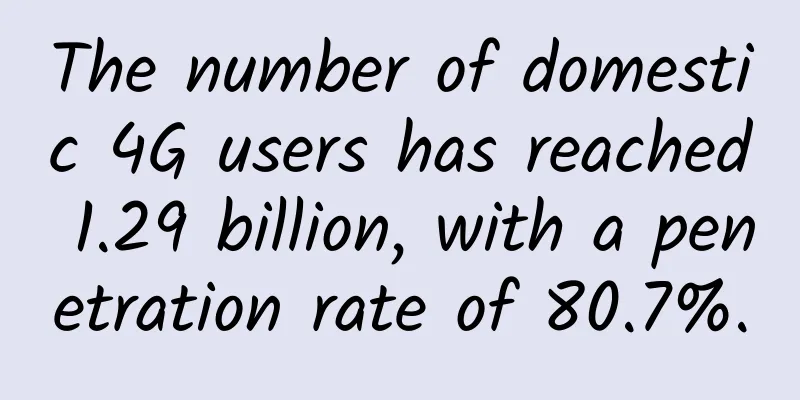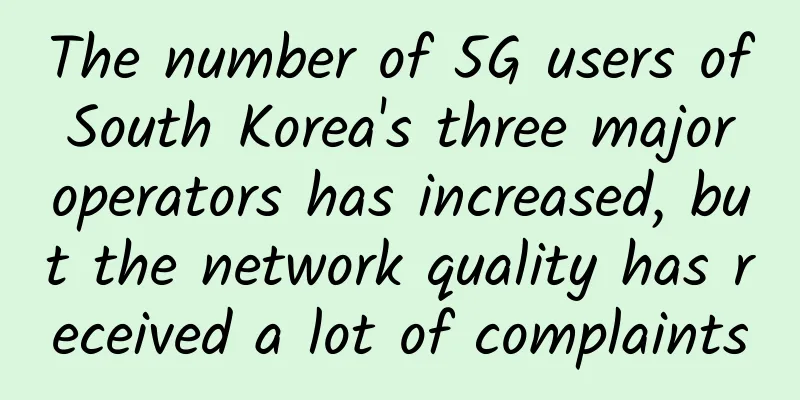CNNIC releases the 49th "Statistical Report on Internet Development in China"

|
The China Internet Network Information Center (CNNIC) released the 49th "Statistical Report on the Development of China's Internet" (hereinafter referred to as the "Report") in Beijing. The report shows that as of December 2021, the number of Internet users in my country reached 1.032 billion, an increase of 42.96 million from December 2020, and the Internet penetration rate reached 73.0%. The network infrastructure has been fully built and the industrial Internet has made positive progressThe report shows that in terms of network basic resources, as of December 2021, the total number of domain names in my country reached 35.93 million, and the number of IPv6 addresses reached 63,052 blocks/32, a year-on-year increase of 9.4%; the proportion of IPv6 traffic in mobile communication networks has reached 35.15%. In the information and communication industry, as of December 2021, a total of 1.425 million 5G base stations have been built and put into operation, and the number of new 5G base stations has reached 654,000 throughout the year; there are more than 150 industrial Internet platforms with national influence, and the total number of access devices exceeds 76 million sets. There are more than 2,000 "5G+Industrial Internet" projects under construction nationwide, and the integrated innovative application of industrial Internet and 5G in key industries of the national economy is accelerating. The number of Internet users has grown steadily, and rural and elderly groups are integrating into the Internet society at an accelerated pace.The report shows that the overall scale of my country's Internet users continued to grow in 2021. First, the gap in Internet access between urban and rural areas continued to narrow. my country's existing administrative villages have fully realized "broadband access in every village", and problems such as communication difficulties in poor areas have been historically solved. The scale of rural Internet users in my country has reached 284 million, and the Internet penetration rate in rural areas is 57.6%, an increase of 1.7 percentage points from December 2020, and the difference in Internet penetration rates between urban and rural areas has narrowed by 0.2 percentage points from December 2020. Second, the elderly group is accelerating its integration into the network society. Thanks to the continuous advancement of the Internet application adaptation transformation action, the vitality of the elderly group's demand for Internet access, Internet access, and Internet use has been further stimulated. As of December 2021, the scale of elderly Internet users aged 60 and above in my country reached 119 million, and the Internet penetration rate reached 43.2%. The elderly group shares the achievements of informatization development with other age groups. The proportion of elderly Internet users who can independently complete online activities such as showing health codes/trip cards, purchasing daily necessities, and searching for information has reached 69.7%, 52.1%, and 46.2%, respectively. The total time spent online by netizens continues to grow, and the devices used for online access are becoming more diversified.The report shows that the Internet usage behavior of Chinese netizens presents new characteristics: First, the average online time per person continues to grow. As of December 2021, the average weekly online time of Chinese netizens reached 28.5 hours, an increase of 2.3 hours from December 2020, and the Internet is deeply integrated into people's daily lives. Second, the use of Internet terminal devices is more diversified. As of December 2021, the proportion of Chinese netizens using mobile phones to access the Internet reached 99.7%, and mobile phones are still the main device for accessing the Internet; the proportion of netizens using desktop computers, laptops, TVs and tablets to access the Internet was 35.0%, 33.0%, 28.1% and 27.4% respectively. Instant messaging and other applications are widely used, and online medical and office users are growing fastestThe report shows that the scale of Internet application users in my country maintained steady growth in 2021. First, applications such as instant messaging have basically been popularized. As of December 2021, among netizens, the user usage rates of instant messaging, online video, and short video were 97.5%, 94.5%, and 90.5%, respectively, and the user scales reached 1.007 billion, 975 million, and 934 million, respectively. Second, applications such as online office and online medical care maintained rapid growth. As of December 2021, the user scales of online office and online medical care reached 469 million and 298 million, respectively, up 35.7% and 38.7% year-on-year, respectively, becoming the two types of applications with the fastest user growth; the user scale growth rates of online food delivery and online car-hailing followed closely, up 29.9% and 23.9% year-on-year, respectively, and the user scales reached 544 million and 453 million, respectively. The China Internet Network Information Center (CNNIC) released the 49th "Statistical Report on the Development of China's Internet" (hereinafter referred to as the "Report") in Beijing. The Report focuses on six aspects, including Internet infrastructure construction, Internet user scale and structure, Internet applications, industrial Internet, Internet government services and Internet security, and strives to comprehensively reflect the overall development of my country's Internet in 2021 through multi-angle and all-round data presentation. The construction of information and communication networks has been steadily advancing, and the industrial Internet has made positive progressHuang Chengqing, vice chairman of the Internet Society of China, said that 2021 is the 100th anniversary of the founding of the Communist Party of China, the beginning of the "14th Five-Year Plan", and a critical period for building a cyber power and digital China and promoting the high-quality development of the information and communication industry. As a strategic, basic and leading industry supporting economic and social development, the information and communication industry has achieved leapfrog development in recent years. The Ministry of Industry and Information Technology issued the "14th Five-Year Plan for the Development of the Information and Communication Industry", which provides a solid guarantee for promoting the high-quality development of the information and communication industry. The 49th "Report" released by CNNIC shows that my country's information and communication network construction is progressing steadily and the industrial Internet has made positive progress. First, the information and communication industry has achieved leapfrog development, providing a strong new impetus for economic and social development. The number of mobile phone base stations has continued to grow, and the construction of 5G networks has steadily advanced. As of December 2021, the total number of mobile phone base stations in my country reached 9.96 million, with a total of 1.425 million 5G base stations built and put into operation, and the number of new 5G base stations reached 654,000 throughout the year. The scale of mobile phone users has increased steadily, and the scale of 5G users has expanded rapidly. As of December 2021, the total number of mobile phone users reached 1.643 billion, of which 5G mobile phone users reached 355 million. The number of fixed broadband access users has grown steadily, and the number of gigabit users has steadily increased. As of December 2021, the total number of fixed Internet broadband access users of the three basic telecommunications companies reached 536 million, a net increase of 52.24 million over the end of the previous year. Among them, the number of fixed Internet broadband access users with access speeds of 1000Mbps and above reached 34.56 million, a net increase of 28.16 million over the end of the previous year. Second, the development of my country's industrial Internet has been steadily advancing, and the application of "5G+Industrial Internet" has been deeply developed. The network foundation, platform hub, data elements, and security guarantee role of the industrial Internet have been further demonstrated. The construction of the network system has been continuously promoted, basic telecommunications enterprises have accelerated the construction of external networks, industrial enterprises have promoted the transformation and upgrading of internal networks, and five national top nodes have been built and are operating stably; the depth of the platform system has been continuously expanded, and there are more than 150 industrial Internet platforms with national influence, and the total number of access devices has exceeded 76 million sets; data aggregation and empowerment have begun to show results, and the National Industrial Internet Big Data Center has formed a systematic layout covering the Beijing-Tianjin-Hebei, Yangtze River Delta, Guangdong-Hong Kong-Macao Greater Bay Area, and Chengdu-Chongqing Twin Cities Economic Circle; the security system guarantee capability has been continuously improved, the top-level design has been continuously improved, and the threat monitoring and information notification and disposal have been continuously strengthened. "5G+Industrial Internet" accelerates the construction of new infrastructure, application models and industrial ecology that are deeply integrated with the industrial economy. The Ministry of Industry and Information Technology has encouraged relevant units to draw on the two batches of 20 typical scenarios and 10 key industry application practices of "5G+Industrial Internet" that have been released, closely follow the characteristics and needs of the industry, explore more application scenarios, and promote the deep integration of "5G+Industrial Internet" with the real economy. At present, it has achieved remarkable application results in industries such as electronic equipment manufacturing, equipment manufacturing, steel, mining, and electricity, and has played a greater role in promoting the development of my country's digital economy. The development of digital government construction is accelerating, helping to promote the modernization of national governanceWang Yimin, director of the E-Government Research Center of the Party School of the Central Committee of the Communist Party of China (National School of Administration) and deputy director of the National E-Government Expert Committee, said that the "14th Five-Year Plan" outline proposes to "promote the construction of a cyber power, accelerate the construction of a digital economy, digital society, and digital government, and use digital transformation to drive the overall transformation of production methods, lifestyles, and governance methods." In 2021, as the construction of a national integrated government service platform with the national government service platform as the general hub gradually shows results, the development of online government services in my country has begun to move from a one-way service stage dominated by information services to an overall service stage characterized by cross-regional, cross-departmental, and cross-level integrated government services. The national integrated government service platform is becoming an important means of innovating administrative management and optimizing the business environment, and an important channel for serving the people. First, the construction of digital government is accelerating, and the modernization level of my country's national governance capacity is constantly improving. New technologies such as big data, cloud computing, mobile Internet, Internet of Things, and artificial intelligence are constantly applied to the government governance process. The digital transformation of the national government is steadily progressing, and government service platforms, supervision platforms, and a national credit system have been formed. The construction of digital government has become a key tool for realizing the digital transformation of government affairs, driving high-quality innovative development of the economy and society, and promoting the modernization of the national governance system and governance capabilities. Development models such as Zhejiang's "run once at most" reform, Jiangsu's "non-face-to-face approval (service)" reform, and Shanghai's "one-stop service" reform have effectively solved the problems of difficulty, slowness, and annoyance in handling affairs for the masses and enterprises, and driven the Internet government services to accelerate development from point to surface and from shallow to deep. Second, the integrated government service capabilities have been significantly improved, becoming a typical feature of my country's current digital government construction. All provinces and cities in my country have actively explored and built a "one network" of government services that are inclusive, equal, convenient, efficient, intelligent and accurate. With the original intention of "doing practical things for the people", they have focused on the difficulties and problems of online services and "urgent, difficult and anxious" problems, and worked hard to improve service levels and service efficiency, and strived to write a people's livelihood answer sheet that is convenient for the people and beneficial to enterprises. The national integrated government service platform has more than 1 billion real-name users, of which more than 400 million are registered users of the national government service platform, with a total usage of 36.82 billion times, providing more than 2.9 billion identity authentication and verification services for local departments, and the satisfaction and sense of gain of the people have been continuously improved. Third, the construction of the national government service platform has continued to play a role, effectively stimulating market vitality and promoting the improvement of the business environment. In order to implement the deployment requirements of the Central Economic Work Conference and the State Council Executive Meeting on helping market entities, especially small, medium and micro enterprises and individual industrial and commercial households, reduce burdens and difficulties, and resume development, in 2021, the National Integrated Government Service Platform launched the "Enterprise Relief Service Zone", which collected 1,262 local and departmental policies to help enterprises and alleviate difficulties. A total of 1,154 services have been connected to various terminals and continued to be enriched and improved, promoting the precise matching, personalized push, and one-stop handling of policies to help enterprises and alleviate difficulties for enterprises, forming a closed management loop for querying, handling, feedback, and improving policies to help enterprises and alleviate difficulties, and promoting various services to be easy to handle, so that enterprises can enjoy policies more quickly, more conveniently, and more accurately, and directly access services, which are generally welcomed by enterprises and the public. Internet use by minors presents new characteristics, and network protection mechanisms are gradually being establishedWang Sixin, deputy director of the Institute of Community of Shared Future for Mankind at Communication University of China, said that with the high popularity of the Internet among minors, the Internet has become an important learning, social and entertainment tool for contemporary minors, and its role in their growth process is becoming increasingly prominent. The 49th CNNIC Report focused on the relevant situation of Internet use by minors in my country in the form of a special topic, and found the following three main characteristics: First, in terms of urban and rural differences, the Internet penetration rate of minors has basically leveled off. The Internet penetration rate of minors in urban areas in my country has reached 95.0%, and in rural areas it is 94.7%, which is basically the same now. However, in terms of the depth and breadth of Internet applications, there are still large differences in the application level of urban and rural minors. The proportion of urban minors using applications with strong social attributes such as search engines, social networking sites, news, and shopping is significantly higher, while rural minors prefer to use leisure and entertainment applications such as short videos, animations or comics. Second, in terms of Internet access devices, new smart terminals are rapidly gaining popularity among minors. Mobile phones are currently the primary Internet access device for minors, and the ownership rate among this group has reached 65.0%. In addition, smart watches, as a representative product of new smart terminals, have also reached 25.3% among underage netizens. As related industries such as smart devices and 5G become increasingly mature, new smart devices such as smart watches and smart desk lamps are rapidly gaining popularity among minors. Third, in terms of rights protection, relevant policies have been introduced to improve the level of protection of minors' online rights. In September 2021, the State Council issued the "Outline for China's Children's Development (2021-2030)", requiring the strengthening of online protection for minors and the implementation of the protection responsibilities of the government, enterprises, schools, families, and society. In addition, the State Press and Publication Administration issued the "Notice on Further Strict Management to Effectively Prevent Minors from Being Addicted to Online Games", strictly limiting the time that companies can provide online game services to minors. In the next step, it is still necessary to gather forces from all walks of life, strengthen scientific popularization and publicity and education, and jointly create a good online cultural atmosphere for minors. |
>>: Google open-sources network-opt for optimizing network topology
Recommend
Research on 4G network coverage quality assessment method in rural areas
Labs Guide The analysis of 4G coverage quality in...
How much do you know about Zigbee wireless connection?
Zigbee has a wide range of applications and can o...
Why are private operators becoming more and more popular while the three major operators are being neglected?
In 2013, the Ministry of Industry and Information...
Network Slicing "Hot Pot Theory": Same Pot, Different Dreams
In the dog days of summer, when people are "...
A brief analysis of the integration solution of Hyperscan in nDPI
Labs Guide Hyperscan is a high-performance regula...
CloudCone Los Angeles SSD VPS Flash Sale $19.38/year - 1GB/30GB SSD/1TB monthly traffic
CloudCone launched the SSD VPS Flash Sale yesterd...
Four questions and answers to help you understand the principles and applications of blockchain in seconds
Starting with Bitcoin, the decentralized and data...
Do you know how wireless networks developed?
MediaTek recently released its flagship 5G mobile...
5G is coming: 3 ways it will benefit your business
5G is still on the way, and telecom operators are...
Top 10 SDN Solutions of 2018 (So Far)
Software is the front and center of the network w...
Transforming the network to support remote work as a norm
Before the COVID-19 pandemic, remote work was mor...
∑co Time | Empowering the edge from the "core" to unlock the smart password of edge data
The cities we live in are becoming more and more ...
Protocol-Oriented Programming and Cocoa (Part 1)
[[403413]] This article is reprinted from the WeC...
AnalyticDB PostgreSQL teaches you how to implement distributed consistent backup and recovery
1. Background AnalyticDB for PostgreSQL (ADB PG f...
What secrets do you not know about the spanning tree protocol?
1. Spanning Tree Protocol (STP) Compaq was long a...









